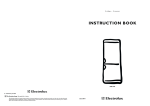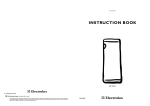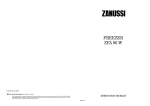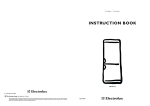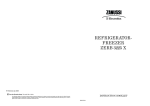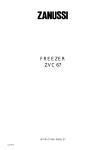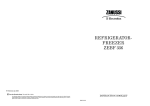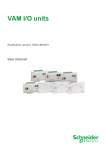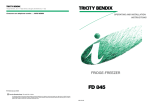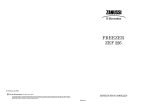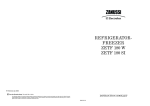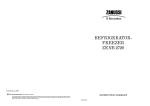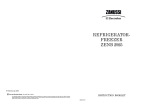Download Electrolux U24089 User's Manual
Transcript
fridge - freezer INSTRUCTION BOOK ERH 3620 X © Electrolux plc 2003 2222 089-72 IMPORTANT SAFETY INFORMATION It is most important that this instruction book should be retained with the appliance for future reference. Should the appliance be sold or transferred to another owner, or should you move house and leave the appliance, always ensure that the book is left with the appliance in order that the new owner can get to know the functioning of the appliance and the relevant safety information. This information has been provided in the interest of safety. You MUST read it carefully before installing or using the appliance. 17.Remove the three caps (N) inserted in the late for the hinge screws and mount them on the opposite side; 18.Remove the washer (P) from the upper middle hinge, remove the pin and mount it on the other side by fitting the washer on the pin and positioning the whole group on the other side; 19.Mount the door again. Leave the door open and fasten the upper middle hinge with the two screws in the inner holes. Installation • Do not place carbonated or fizzy drinks in the freezer. 20.Close the door and tighten the third screw in the hole. • • Do not remove items from the freezer if your hands are damp/wet, as this could cause skin abrasions or frost/freezer burns. • Ice lollies can cause ‘frost/freezer burns’ if consumed straight from the freezer. 21.Unscrew the handles. Refit them on the opposite side after having pierced the plugs with a punch. Cover the holes left open with the plugs contained in the documentation pack. • Manufacturers’ storage recommendations should be strictly adhered to. Refer to relevant instructions. • • • • • This appliance is heavy. Care should be taken when moving it. It is dangerous to alter the specifications or attempt to modify this product in any way. Care must be taken to ensure that the appliance does not stand on the electrical supply cable. Important: if the supply cable is damaged, it must be replaced by a special cable available from the manufacturer or its service agent. Any electrical work required to install this appliance should be carried out by a qualified electrician or competent person. Parts which heat up should not be exposed. Whenever possible, the back of the appliance should be close to a wall but leaving the required distance for ventilation as stated in the installation instructions. The appliance should be left for 2 hours after installation before it is turned on, in order to allow the refrigerant to settle. • The cooling plate or refrigerated freezer shelves in this appliance contain channels through which the refrigerant passes. If these are punctured this will cause substantial damage to the appliance and result in food loss. DO NOT USE SHARP INSTRUMENTS to scrape off frost or ice. Under NO circumstances should solid ice be forced off the lining or shelves. Solid ice should be allowed to thaw, when defrosting the appliance. See Defrost Instructions. Child Safety Maintenance and Cleaning • Do not allow children to tamper with the controls or play with the product. • • Keep all packaging well away from children. Servicing General Safety • • • • Take utmost care when handling your appliance so as not to cause any damages to the cooling unit with consequent possible fluid leakages. The appliance must not be located close to radiators or boilers. Avoid prolonged exposure of the appliance to direct sunlight. Do not use other electrical appliances (such as ice cream makers) inside of refrigerating appliances, unless they are approved for this purpose by the manufacturer. During Use • This appliance is designed for domestic use only, specifically for the storage of edible foodstuffs only. • Frozen food must NOT be re-frozen once it has thawed out. 2 PR220 Important After completion of the door reversing operation, check that the door gasket adheres to the cabinet. If the ambient temperature is cold (i.e. in Winter), the gasket may not fit perfectly to the cabinet. In that case, wait for the natural fitting of the gasket or accelerate this process by heating up the part involved with a normal hairdryer on a low setting. Switch off and unplug the appliance before carrying out any cleaning or maintenance work. • This product should be serviced by an authorised engineer and only genuine spare parts should be used. • Under no circumstances should you attempt to repair the machine yourself. Repairs carried out by inexperienced persons may cause injury or serious malfunctioning. Refer to your local Electrolux Service Force Centre and always insist on genuine spare parts. At the end of the Appliance Life • When disposing of your appliance, use an authorised disposal site. • Remove the plug and ensure that any locks or catches are removed, to prevent young children being trapped inside. Printed on recycled paper 19 Fastening to the wall Rear spacers Warning! In the bag with the documentation, there are two spacers which must be fitted as shown in the figure. 1,5 cm Slacken the screws and insert the spacer under the screw head, then re-tighten the screws. Take the bag supplied with the appliance. It contains the following accessories: 2 brackets 4 wall plugs (for fixing to masonry wall) D594 4 screws 1 10 mm wrench E F The accessory bag containing: E Proceed as follows to carry out the fastening: F F door fastener In order to reverse the door proceed as follows: 2. Measure 200 cm from the floor. At the point where the height and the centre meet measure 15 cm to right and 15 cm to the left. Make two 8 mm holes on the left with a drill bit. D 1. Disconnect from the electricity supply. F For masonry walls: M 3. Remove the ventilation grill (D). P N 5. Remove the lower door by sliding it out of the middle hinge (I). Remove the hole cap for the hinge pin and mount it on the other side; L 6. Remove the lower middle hinge (I), remove the pin and mount it on the other side; D753 5. Fasten the brackets horizontally in the lower set of holes as illustrated in the figure after having previously removed the screws. 90° 6. Push the appliance towards the wall and turn the brackets downwards 90°. Make sure that the lower part of the brackets is located between the appliance and the plate. I 7. Insert the second set of screws in the upper holes and complete the fastening. 3P004 For dry lined walls: 9. Mount the lower door; 4. Insert the wall plugs by screwing them into the holes drilled previously. 10.Remove the pin of the lower hinge and mount it on the other side; 12.Mount the aeration grid (D) again by snapping it into place; 1,5 cm 4. Insert the 4 metal wall plugs and tighten the screws. 8. Mount the hinge on the other side; 11.Mount the lower hinge (E) on the other side, remove hole cap (F) from the aeration grid (D) by pressing it in the direction indicated by the arrow and mount it on the other side; 15 cm 3. Repeat the operation on the right with the drill (see figure). PR18 4. remove the bottom hinge (E) by unscrewing its three fixing screws; 15 cm 1. Find the appliance’s positioning center. 200 cm 1 slotted screwdriver 7. Remove the screw hole cover caps (L) on the plate on the other side and mount them where the hinge has just been removed; D742 4 wall plugs (for fixing to dry lined walls) 1 cross-slotted screwdriver 2. Gently lay the fridge/freezer on its back with the top held away from the floor by 5-8 cm (2-3 inches) of packing; 200 cm The appliance must be fastened to the wall for safety reasons. Door reversal directions Before reversing the door make sure that the following tools are available: 15 cm 15 cm G D743 5. Fasten the brackets horizontally in the lower set of holes with the screws as illustrated in the figure. 6. Push the appliance towards the wall and turn the brackets downwards 90°. Make sure that the lower part of the brackets is located between the appliance and the plate. 13.Remove the three screws of the upper middle hinge (M); 7. Tighten the screws previously loosened and complete the fastening with the second set of screws. 14.Remove the fridge door by releasing it from the top hinge pin (G). Once the appliance is fastened to wall, make sure that it is stable. 15.Remove the upper door by sliding it off the upper pin (A); remove the door hole cap for the hinge pin and mount it on the other side: 16.Unscrew the upper pin (A) and mount it on the other side; 18 3 CONTENTS Electrical connections Instructions for the User The plug moulded onto the lead incorporates a fuse. For replacement, use a 13amp BSI362 fuse. Only ASTA or BSI approved fuses should be used. Any electrical work required to install this appliance should be carried out by a qualified electrician or competent person. The plug must not be used if the fuse cover/carrier is lost. The cover/carrier is indicated by the coloured insert at the base of the plug. WARNING: THIS APPLIANCE MUST BE EARTHED. A replacement cover/carrier must be obtained from your local Electrolux Service Force Centre. The manufacturer declines any liability should this safety measure not be observed. This appliance complies with the E.E.C. Directive No. 87/308 of 2.6.87 relative to radio interference suppression. Important Safety Information 2 Instructions for the Installer Fastening to the wall 3 Technical Specification 15 Operation 5 Installation 16 Before use 5 Positioning 16 If the plug that is fitted to your appliance is not suitable for your socket outlet, it must be cut off and the appropriate plug fitted. Control panel 5 Shelf holders 16 Remove the fuse from the cut off plug. - The cut off plug should then be disposed of to prevent the hazard of shocks in case it should be plugged into a 13amp socket in another part of your home. 73/23 EEC of 19.2.73 (Low Voltage Directive) and subsequent modifications; - 89/336 EEC of 3.5.89 (Electromagnetic Compatibility Directive) and subsequent modifications. Starting your appliance 5 Electrical Connection 17 Temperature control 5 Rear Spacers 18 Freezing fresh food 5 Door Reversal 18 Frozen food storage 6 Important Thawing 7 Making ice cubes 7 The wires in the mains lead are coloured in accordance with the following code: Fresh food refrigeration 7 Green and Yellow - Earth Movable shelves 8 Blue - Neutral Positioning the door shelves 8 Brown - Live Hints and Tips 9 Maintenance and Cleaning 10 Internal cleaning 10 External cleaning 10 When the appliance is not in use 10 Changing the light bulb 10 Defrosting 11 Something Not Working 12 Service and Spare Parts If you fit your own plug, the colours of the wires in the mains lead of your appliance may not correspond with the markings identifying the terminals in your plug, proceed as follows: GREEN & YELLOW D207 13 Guarantee Conditions 14 13 AMP. FUSE BROWN BLUE 13 Customer Care Please ensure that when the appliance is installed it is easily accessible for the engineer in the event of a breakdown. 13 AMP Use of the adjustable temperature compartment 8 This appliance complies with the following E.E.C. Directives: CORD CLAMP Connect the Green and Yellow (earth) wire to the terminal in the plug which is marked with the letter «E» or the earth symbol yellow. or coloured green and Connect the blue (neutral) wire to the terminal in the plug which is marked with the letter «N» or coloured black. Connect the brown (live) wire to the terminal in the plug which is marked with the letter «L» or coloured red. 4 17 INSTALLATION OPERATION Before use Important IF YOU ARE DISCARDING AN OLD APPLIANCE THAT HAS A LOCK OR CATCH ON THE DOOR, YOU MUST ENSURE THAT IT IS MADE UNUSABLE TO PREVENT YOUNG CHILDREN BEING TRAPPED INSIDE. Depending upon the position which you choose for your appliance, you may wish to reverse the way in which the door opens. To do this, refer to instructions on “Door reversal”. Remove all securing tapes. Wash inside the appliance with lukewarm water and bicarbonate of soda (5 ml to 0.5 litre of water). Do not use soap or detergent as the smell may linger. Dry thoroughly. Control panel Important max SN +10°C to + 32°C N +16°C to + 32°C ST +18°C to + 38°C T +18°C to + 43°C It should be located in a dry atmosphere, out of direct sunlight and away from extreme temperature e.g. not next to a boiler or radiator, or in a very cold room e.g. an outhouse, where the temperatures may fall below 10°C (50°F). If these temperatures are exceeded i.e. colder or warmer, then the appliance may not operate correctly. Adjust the level of the appliance by screwing out the adjustable foot, or feet, at the bottom of the cabinet using your fingers or a tool (see the figure). To remove them proceed as follows: Raise the shelf from the back, push it in the direction of the arrow until it is freed and remove the retainers. 16 B C D max A- Alarm light - Red B- Fast freeze switch C- Fast freeze light - Amber D- Freezer Pilot light - Green E- Freezer Thermostat control knob min ON E F G F- Fridge Pilot light - Green G- Fridge Thermostat control knob B Control Panel Start your appliance A. Alarm light Allow the appliance to stand for 2 hours after installation. NP008 If the alarm light (A) illuminates, it indicates that the temperature within the freezer has reached a level where safe food storage is no longer ensured. When the freezer is first switched on, the alarm light will stay on until the temperature has dropped to a safe level for the storage of frozen food. B. Fast freeze control switch When you place fresh food in the appliance, press the fast freeze control switch. Insert the plug into the wall socket. The pilot light (D) will illuminate to show that the appliance is on. Turn the thermostat control (G) to a midway setting. The pilot light (F) will illuminate. Leave the appliance for approximately 4 hours for the correct temperature to be reached before placing food inside. To switch either section off the appliance turn the thermostat control to position “■” . C. Fast freeze light D200 The fast freeze light is illuminated, to show that the fast freeze function is working. Temperature control D. Freezer pilot light The temperature within the freezer is controlled by the thermostat control (E) situated at the top of the cabinet. The pilot light is illuminated to show that the freezer section is on. A E. Freezer thermostat control knob Turn the thermostat control knob clockwise to required setting. Shelf holders Your appliance is equipped with shelf retainers that make it possible to secure the shelves during transportation. A min ON A You should also ensure that air can circulate freely around the back and the top of the cabinet. There must also be at least 100 mm (4”) distance between the top of the cabinet and any overhanging kitchen furniture (A). Ideally, the appliance should not be positioned beneath overhanging furniture (B). There should also be a gap of 25 mm either side of the appliance. Do not obstruct the space underneath. The back of the cabinet may be placed close to the wall but must not touch it. DO NOT install in places with restricted ventilation. SUPER 15 mm The following table shows which ambient temperature is correct for each climate classification: 100 mm This appliance should only be installed at a location where the ambient temperature corresponds to the climate classification indicated on the rating plate, which is located at the left on the inside of the appliance. ALARM 15 mm Positioning It must be possible to disconnect the appliance from the mains power supply; the plug must therefore be easily accessible after installation. F. Refrigerator pilot light B The pilot light is illuminated to show that the refrigerator section is on. To operate the freezer proceed as follows: Turn the thermostat control knob beyond the «■» position. When you first start the freezer, we suggest that you turn the thermostat control to a medium setting. For easier turning of this control, use a small coin.The internal temperature of the freezer is automatically adjusted by the thermostat to ensure safe food storage. G. Refrigerator thermostat control knob Turn the thermostat control knob clockwise to required setting. 5 However, if the appliance is working in unfavourable room conditions such as Frozen food storage - poor ventilation, - high temperature, - frequent door openings, When you first start the freezer or if the freezer has been out of use for some time, we advise you to run your appliance for at least 12 hours in the «fast freeze» mode before storing frozen food. it may be necessary to select a more suitable setting. In determining the correct temperature control setting all these factors have to be considered and some experimentation may be necessary. When altering the temperature setting, allow 24 hours for the temperature to stablise before making further changes To obtain a lower temperature, turn the thermostat control towards max; to obtain a higher temperature turn the control towards min. For easier turning of this control, use a small coin. Freezing fresh food To obtain the best performance from this appliance, you should: If large quantities of food are to be stored, remove all drawers and baskets from appliance and place food on the cooling shelves. Pay careful attention not to exceed load limit stated on the side of the upper section (where applicable). Do not exceed the storage period indicated by the manufacturer. Finally, do not open the door frequently or leave it open longer than is absolutely necessary. Do not put carbonated liquids, (fizzy drinks etc.), in the freezer compartment. When you first start the freezer or after a period of non-use, press the fast freeze switch 12 hours before you want to freeze your food (the yellow light (C) illuminates). Ice Iollies, if consumed immediately after removal from the freezer, can possibly result in a low temperature skin burn. This time can be shortened, depending on the quantity of food to be frozen. After the time has elapsed place the food to be frozen in the upper compartment of the freezer as these are the coldest parts. In order to freeze the quantity indicated on the rating plate, arrange the food directly in contact with the cooling surfaces. If the food is frozen in the baskets, the maximum quantity that can be frozen is slightly less. Once the food is completely frozen (which could take up to 24 hours) press again the fast freeze switch; the yellow light (C) goes out. DIMENSIONS Height 200 cm Width 60 cm Depth 60 cm POWER SUPPLY VOLTAGE AND FREQUENCY 220-240 V / 50 Hz TOTAL POWER ABSORBED 200 W AVERAGE DAILY UNITS ELECTRICITY * 0.959 kWh GROSS CAPACITY 184 l Important In any 24 hour period you can freeze up to 14 kg of fresh food. If the freezer is already in operation, the fast-freeze switch should be pressed about 2-3 hours before freezing fresh food. TECHNICAL SPECIFICATIONS NET CAPACITY Do not remove items from the freezer if your hands are damp/wet, as this could cause skin abrasions or “frost/freezer burns”. Fridge Cellar zone 88 l Freezer 88 l Fridge 180 l Cellar zone 80 l Freezer 82 l Important In the event of a power cut do not open the door. The food in the freezer will not be affected if the power cut is short and if the freezer is full. Should the food begin to thaw, it must be consumed quickly and must not be re-frozen. STAR RATING * This figure is based on standard test results in accordance with European Standard EN 153. Actual consumption will depend on how the appliance is used and where it is located. Distribute the frozen food packages in the other compartments, so that the top compartments can be used for a further freezing operation. - The food to be frozen must be fresh and of the best quality. - Do not allow fresh food to touch food which is already frozen. - During the freezing process, ensure that the freezer door remains closed. 6 15 GUARANTEE CONDITIONS Standard guarantee conditions We, Electrolux, undertake that if within 12 months of the date of the purchase this Electrolux appliance or any part thereof is proved to be defective by reason only of faulty workmanship or materials, we will, at our option repair or replace the same FREE OF CHARGE for labour, materials or carriage on condition that: The appliance has been correctly installed and used only on the electricity supply stated on the rating plate. The appliance has been used for normal domestic purposes only, and in accordance with the manufacturer’s instructions. The appliance has not been serviced, maintained, repaired, taken apart or tampered with by any person not authorised by us. All service work under this guarantee must be undertaken by an Electrolux Service Force Centre. Any appliance or defective part replaced shall become the Company’s property. This guarantee is in addition to your statutory and other legal rights. Home visits are made between 8.30am and 5.30pm Monday to Friday. Visits may be available outside these hours in which case a premium will be charged. Exclusions This guarantee does not cover: Damage or calls resulting from transportation, improper use or neglect, the replacement of any light bulbs or removable parts of glass or plastic. Thawing Fresh food refrigeration Frozen food, prior to being used, can be thawed in the fridge or at room temperature depending on the time available. Small food items may even be cooked from frozen; in this case cooking will take longer. To obtain the best performance, do not store warm food or evaporating liquids in the refrigerator; do cover or wrap the food, particularly if it has a strong flavour. Any frozen food which is allowed to thaw accidentally should either be eaten as soon as possible or thrown away. Alternatively, if the food is uncooked and has not been completely defrosted it can be cooked and then refrozen. Do not cover the shelves with any protective material, such as paper, cardboard or plastic, which may obstruct the air circulation through them. Meat, fish and fruit should be thawed in the refrigerator compartment and small pieces of meat can even be cooked while still frozen, but you must ensure that it is thoroughly cooked through. Raw meat (beef, pork, lamb & Poultry): wrap in polythene bags and place on the glass shelf on the top of the salad drawer. Vegetables should be directly immersed in boiling water; ready-cooked dishes can be placed directly in the oven in their aluminium wrapping. A microwave oven is particularly suitable for thawing any type of frozen or deep-frozen food: follow the oven instructions, particularly regarding the placement of aluminium wrapping or containers in the oven. Defrosted cooked food must never be refrozen. To help you use your refrigerator correctly, here are some more useful hints: Meat can only be stored safely in this way for one or two days at the most. Fruit & vegetables: these should be thoroughly cleaned and placed in the salad drawer. Butter & cheese: these should be placed in special airtight containers or wrapped in aluminium foil or polythene bags to exclude as much air as possible. Milk bottles: these should have a cap and should be stored in the bottle rack on the door. Costs incurred for calls to put right an appliance which is improperly installed or calls to appliances outside the European Community (EC) or European Free Trade Area. Appliances found to be in use within a commercial environment, plus those which are subject to rental agreements. Products of Electrolux manufacture which are not marketed by Electrolux. European Guarantee If you should move to another country within Europe then your guarantee moves with you to your new home subject to the following qualifications: Making ice cubes The appliance is provided with one or more trays for ice-cubes trays. Fill the tray(s) 3/4 full to give the ice space to expand and place them in the freezer compartment. The guarantee starts from the date you first purchased your product. To release the ice cubes simply give the tray a slight twist. The guarantee is for the same period and to the same extent for labour and parts as exists in the new country of use for this brand or range of products. Do not use sharp or metallic instruments to remove the trays from the freezer. This guarantee relates to you and cannot be transferred to another user. Your new home is within the European Community (EC) or European Free Trade Area. The product is installed and used in accordance with our instructions and is only used domestically, i.e. a normal household. The product is installed taking into account regulations in your new country. Before you move please contact your nearest Customer Care centre, listed below, to give them details of your new home. They will then ensure that the local Service Organisation is aware of your move and able to look after you and your appliances. France Senlis +33 (0)3 44 62 20 13 Germany Nürnberg +49 (0)800 234 7378 Italy Pordenone +39 (0)800117511 Sweden Stockholm +46 (0)20 78 77 50 UK Slough +44 (0)1753 219898 14 7 SERVICE AND SPARE PARTS Movable shelves The walls of the refrigerator have runners so that shelves can be positioned as desired. In the event of your appliance requiring service, or if you wish to purchase spare parts, please contact your local Electrolux Service Force Centre by telephoning:- 0870 5 929929 Your telephone call will be automatically routed to the Service Force Centre covering your post code area. D338 For the address of your local Service Force Centre and further information about Service Force, please visit the website at www.serviceforce.co.uk Positioning the door shelves Before calling out an engineer, please ensure you have read the details under the heading ‘Something Not Working.’ To permit storage of food packages of various sizes, the door shelves can be adjusted in height. When you contact the Service Force Centre you will need to give the following details: To do this proceed as shown in the diagram. 1. Your name, address and post code 2. Your telephone number 3. Clear and concise details of the fault 4. The model and serial number of the appliance (found on the rating plate) 5. The purchase date PR249 Please note that a valid purchase receipt or guarantee documentation is required for in-guarantee service calls. CUSTOMER CARE DEPARTMENT Use of the adjustable temperature compartment For general enquiries concerning your Electrolux appliance or for further information on Electrolux products, please contact our Customer Care Department by letter or telephone at the address below or visit our website at www.electrolux.co.uk Temperature adjustment Customer Care Department Electrolux The temperature can be adjusted either with the thermostat (see refrigerator temperature adjustment) or by means of the flaps (air inlets) located in the refrigerator compartment. When the flaps (A) are closed, the temperature in the adjustable temperature compartment is usually +3 to +5°C warmer than the refrigerator compartment. When the flaps are open the temperature in both compartments is the same. 55-77 High Street Slough A 3P002 Berkshire SL1 1DZ Tel: 08705 950 950 * * calls to this number may be recorded for training purposes. Use The adjustable temperature compartment is suitable for vegetables, fruit and beverages. Thanks to the separators food can be divided by type. Remove the container as illustrated in the figure to clean the adjustable temperature compartment. 3P001C 8 13 SOMETHING NOT WORKING HINTS AND TIPS Important: If you call out an engineer to a fault listed below, or to repair a fault caused by incorrect use or installation a charge will be made, even if the appliance is under guarantee. Before contacting your local Service Force Centre, check the following points: Normal Operating Sounds Symptom Solution No power to the appliance Check there is power at the socket. Check there is not a power cut by checking the household lights. • • • Check the fuse has not blown. The light does not come on Ensure that the bulb is correctly fitted. You may hear faint gurgling or bubbling sounds when the refrigerant is pumped through the coils or tubing at the rear, to the cooling plate/evaporator. • Do not install the appliance close to sources of heat, such as a boiler or radiator. • When the compressor is on, the refrigerant is being pumped round, and you will hear a whirring sound or pulsating noise from the compressor. Locate the appliance in a cool well ventilated room and make sure that the air openings of the appliance are not obstructed. • A thermostat controls the compressor, and you will hear a faint ’click’ when the thermostat cuts in and out. Avoid unnecessary frosting in the cabinet by packing all foodstuffs into airtight packages before placing them in the freezer. • Always leave warm food to cool down to room temperature before placing in the fridge. • Food which is to be frozen (when cool) should be placed in the fridge before being transferred to the freezer. Food Storage Replace the bulb if it has blown. Check the door light switch is not jammed. The temperature in the fridge or freezer section is too high Check the thermostat control knob for the fridge or freezer is turned to the correct setting relative to ambient conditions. Check the ambient temperature is within the appliance’s operating limits, please refer to the installation section in this instruction book. Relocate the appliance if necessary. To obtain the best performance from your fridgefreezer • Do not store warm food or evaporating liquids. • • Avoid buying frozen food if you cannot store it straight away. The use of an insulated container is advisable. When you arrive home place the frozen food in the freezer immediately. Thaw frozen food in the fridge. This will ensure safer defrosting of foods and reduce the work of the refrigeration unit. • Try to avoid keeping the door open for long periods or opening the door too frequently as warm air will enter the cabinet and cause the compressor to switch on unnecessarily often. • Ensure there are no obstructions preventing the door from closing properly. • Keep the time between buying chilled food and placing it in your refrigerator as short as possible. • Do not push food together too much, try to allow air to circulate around each item. • Do not store food uncovered. • Ensure that food placed in the freezer is dated and labelled and used in date order to ensure that food is consumed at its best. Check that the fast freeze function is not in use. • Remove suspect food from your refrigerator and clean, refer to Maintenance and Cleaning. Large quantities of food have recently been placed in the cabinet and/or door is frequently opened. • Lean food keeps better and longer than fatty food, salt reduces the storage time. Check that air ventilation is not obstructed. • Wrap the food in polythene or aluminium freezing bags or foil so that they adhere to the food and provide an airtight seal . • Packaging which is swollen or has traces of refrozen water droplets on the pack could indicate that the product has not been kept at a suitable temperature and that it may have lost its original quality. Partially thawed food must not be refrozen, it must be consumed within 24 hours. Never exceed the storage times indicated by the manufacturer. • The symbols on the drawers show different types of frozen goods. The freezer door will not open Has door just been opened? If so leave for a few minutes to allow the air pressure to equalise. The compressor(s) runs continuously Adjust the thermostat control knob to give correct temperature control. See “Setting the temperature”. Check that the doors are closed. Excessive frost and ice has built up Ensure the doors are not left open. Check that nothing is preventing the doors from closing. Is the door gasket intact and clean. Has advised periodic defrosting been carried out. Noise Refer to normal operating sounds. Water under the salad bin Check the drain hole is not blocked. (see Maintenance and Cleaning). If, after the above checks, there is still a fault, call your local Service Force Centre. In-guarantee customers should ensure that the above checks have been made as the engineer will make a charge if the fault is not a mechanical or electrical breakdown. Please note that proof of purchase is required for any in-guarantee service calls. 12 Energy Saving Advice In the Event of a Power Failure If there is a power failure during the storage of frozen foods, keep the door closed. If the temperature within your freezer should rise, do not refreeze the food without checking its condition. The following guidelines should assist you: Ice-cream: Once thawed should be discarded. Fruits & Vegetables: If soft should be cooked and used up. Breads & Cakes: Can be refrozen without danger. Shellfish: Should be refrigerated and used up quickly. Cooked Dishes: i. e. casseroles should be refrigerated and used up. Large Pieces of Meat: Can be refrozen providing there are still ice crystals remaining within them. Small Joints: Should be cooked and can then be refrozen as cooked dishes. Chicken: Should also be cooked and refrozen as a fresh dish. The numbers indicate storage times in months for the appropriate types of frozen goods. Whether the upper or lower value of the indicated storage time is valid depends on the quality of the foods and pre-treating before freezing. 9 MAINTENANCE AND CLEANING Before any maintenance or cleaning work is carried out, DISCONNECT the appliance from the ELECTRICITY supply. Refrigerator Changing the light bulb Internal cleaning Clean the inside and accessories with warm water and bicarbonate of soda (5ml to 0.5 litre of water). Rinse and dry thoroughly. NEVER USE DETERGENTS, ABRASIVE POWDERS, HIGHLY PERFUMED CLEANING PRODUCTS OR WAX POLISHES, TO CLEAN THE INTERIOR AS THESE WILL DAMAGE THE SURFACE AND LEAVE A STRONG ODOUR. External cleaning Many proprietary kitchen surface cleaners contain chemicals that can attack/damage the plastics used in this appliance. For this reason it is recommended that the outer casing of this appliance is only cleaned with warm water with a little washing-up liquid added. An accumulation of dust will affect the performance of the appliance and cause excessive electricity consumption. Once or twice a year dust the condenser (black grill) and the compressor at the back of the appliance, with a brush or vacuum cleaner, see figure. PR259 When the appliance is not in use Defrosting The refrigerator automatically defrosts every time the compressor stops. The water is discharged, via the pipe, into a tray located at the back of the appliance above the compressor, where it evaporates. Important D613 Remove the screw from the light cover and then pull it outward toward the middle of the cabinet. Unscrew the bulb and replace it with a new 15 watt bulb (available from your nearest Service Force Centre). Replace the light cover by sliding it into its original position and replacing the screw. To avoid defrost water overflowing into the fridge, periodically clean the water discharge hole in the centre of the V shaped drip collector at the back of the refrigerator compartment behind the salad crispers. Use the defrost cleaner provided which you will find already inserted into the discharge hole. Remember to wash the defrost cleaner in hot soapy water at regular intervals. Dry throughly before replacing. 3P037 Freezer When the frost has reached a thickness of up to 4mm it can be removed using the ice scraper provided with the appliance. During this operation it is not necessary to disconnect the appliance from the mains and remove the food. Never use metal tools for this operation. For complete defrosting (once or twice a year) proceed as follows: - turn the freezer control knob dial to the «OFF» position (■). - Remove any food from inside the freezer and fridge, wrap it in several sheets of newspaper and store in a cool,dry place. - Leave the door open and insert the ice scraper under the channel in the centre of the lower part of the appliance; place a low-sided container beneath the scraper to collect the water (see fig.). - Clean and dry thoroughly. - Replace the scraper in one of the drawers . - Reset the freezer control knob to a medium setting. - After letting the appliance run for at least half an hour, replace the previously removed food into the compartment. D068 When the appliance is not in use for long periods, disconnect from the electricity supply, empty all foods and clean the appliance, leaving the doors ajar to prevent unpleasant smells. 10 11 MAINTENANCE AND CLEANING Before any maintenance or cleaning work is carried out, DISCONNECT the appliance from the ELECTRICITY supply. Refrigerator Changing the light bulb Internal cleaning Clean the inside and accessories with warm water and bicarbonate of soda (5ml to 0.5 litre of water). Rinse and dry thoroughly. NEVER USE DETERGENTS, ABRASIVE POWDERS, HIGHLY PERFUMED CLEANING PRODUCTS OR WAX POLISHES, TO CLEAN THE INTERIOR AS THESE WILL DAMAGE THE SURFACE AND LEAVE A STRONG ODOUR. External cleaning Many proprietary kitchen surface cleaners contain chemicals that can attack/damage the plastics used in this appliance. For this reason it is recommended that the outer casing of this appliance is only cleaned with warm water with a little washing-up liquid added. An accumulation of dust will affect the performance of the appliance and cause excessive electricity consumption. Once or twice a year dust the condenser (black grill) and the compressor at the back of the appliance, with a brush or vacuum cleaner, see figure. PR259 When the appliance is not in use Defrosting The refrigerator automatically defrosts every time the compressor stops. The water is discharged, via the pipe, into a tray located at the back of the appliance above the compressor, where it evaporates. Important D613 Remove the screw from the light cover and then pull it outward toward the middle of the cabinet. Unscrew the bulb and replace it with a new 15 watt bulb (available from your nearest Service Force Centre). Replace the light cover by sliding it into its original position and replacing the screw. To avoid defrost water overflowing into the fridge, periodically clean the water discharge hole in the centre of the V shaped drip collector at the back of the refrigerator compartment behind the salad crispers. Use the defrost cleaner provided which you will find already inserted into the discharge hole. Remember to wash the defrost cleaner in hot soapy water at regular intervals. Dry throughly before replacing. 3P037 Freezer When the frost has reached a thickness of up to 4mm it can be removed using the ice scraper provided with the appliance. During this operation it is not necessary to disconnect the appliance from the mains and remove the food. Never use metal tools for this operation. For complete defrosting (once or twice a year) proceed as follows: - turn the freezer control knob dial to the «OFF» position (■). - Remove any food from inside the freezer and fridge, wrap it in several sheets of newspaper and store in a cool,dry place. - Leave the door open and insert the ice scraper under the channel in the centre of the lower part of the appliance; place a low-sided container beneath the scraper to collect the water (see fig.). - Clean and dry thoroughly. - Replace the scraper in one of the drawers . - Reset the freezer control knob to a medium setting. - After letting the appliance run for at least half an hour, replace the previously removed food into the compartment. D068 When the appliance is not in use for long periods, disconnect from the electricity supply, empty all foods and clean the appliance, leaving the doors ajar to prevent unpleasant smells. 10 11 SOMETHING NOT WORKING HINTS AND TIPS Important: If you call out an engineer to a fault listed below, or to repair a fault caused by incorrect use or installation a charge will be made, even if the appliance is under guarantee. Before contacting your local Service Force Centre, check the following points: Normal Operating Sounds Symptom Solution No power to the appliance Check there is power at the socket. Check there is not a power cut by checking the household lights. • • • Check the fuse has not blown. The light does not come on Ensure that the bulb is correctly fitted. You may hear faint gurgling or bubbling sounds when the refrigerant is pumped through the coils or tubing at the rear, to the cooling plate/evaporator. • Do not install the appliance close to sources of heat, such as a boiler or radiator. • When the compressor is on, the refrigerant is being pumped round, and you will hear a whirring sound or pulsating noise from the compressor. Locate the appliance in a cool well ventilated room and make sure that the air openings of the appliance are not obstructed. • A thermostat controls the compressor, and you will hear a faint ’click’ when the thermostat cuts in and out. Avoid unnecessary frosting in the cabinet by packing all foodstuffs into airtight packages before placing them in the freezer. • Always leave warm food to cool down to room temperature before placing in the fridge. • Food which is to be frozen (when cool) should be placed in the fridge before being transferred to the freezer. Food Storage Replace the bulb if it has blown. Check the door light switch is not jammed. The temperature in the fridge or freezer section is too high Check the thermostat control knob for the fridge or freezer is turned to the correct setting relative to ambient conditions. Check the ambient temperature is within the appliance’s operating limits, please refer to the installation section in this instruction book. Relocate the appliance if necessary. To obtain the best performance from your fridgefreezer • Do not store warm food or evaporating liquids. • • Avoid buying frozen food if you cannot store it straight away. The use of an insulated container is advisable. When you arrive home place the frozen food in the freezer immediately. Thaw frozen food in the fridge. This will ensure safer defrosting of foods and reduce the work of the refrigeration unit. • Try to avoid keeping the door open for long periods or opening the door too frequently as warm air will enter the cabinet and cause the compressor to switch on unnecessarily often. • Ensure there are no obstructions preventing the door from closing properly. • Keep the time between buying chilled food and placing it in your refrigerator as short as possible. • Do not push food together too much, try to allow air to circulate around each item. • Do not store food uncovered. • Ensure that food placed in the freezer is dated and labelled and used in date order to ensure that food is consumed at its best. Check that the fast freeze function is not in use. • Remove suspect food from your refrigerator and clean, refer to Maintenance and Cleaning. Large quantities of food have recently been placed in the cabinet and/or door is frequently opened. • Lean food keeps better and longer than fatty food, salt reduces the storage time. Check that air ventilation is not obstructed. • Wrap the food in polythene or aluminium freezing bags or foil so that they adhere to the food and provide an airtight seal . • Packaging which is swollen or has traces of refrozen water droplets on the pack could indicate that the product has not been kept at a suitable temperature and that it may have lost its original quality. Partially thawed food must not be refrozen, it must be consumed within 24 hours. Never exceed the storage times indicated by the manufacturer. • The symbols on the drawers show different types of frozen goods. The freezer door will not open Has door just been opened? If so leave for a few minutes to allow the air pressure to equalise. The compressor(s) runs continuously Adjust the thermostat control knob to give correct temperature control. See “Setting the temperature”. Check that the doors are closed. Excessive frost and ice has built up Ensure the doors are not left open. Check that nothing is preventing the doors from closing. Is the door gasket intact and clean. Has advised periodic defrosting been carried out. Noise Refer to normal operating sounds. Water under the salad bin Check the drain hole is not blocked. (see Maintenance and Cleaning). If, after the above checks, there is still a fault, call your local Service Force Centre. In-guarantee customers should ensure that the above checks have been made as the engineer will make a charge if the fault is not a mechanical or electrical breakdown. Please note that proof of purchase is required for any in-guarantee service calls. 12 Energy Saving Advice In the Event of a Power Failure If there is a power failure during the storage of frozen foods, keep the door closed. If the temperature within your freezer should rise, do not refreeze the food without checking its condition. The following guidelines should assist you: Ice-cream: Once thawed should be discarded. Fruits & Vegetables: If soft should be cooked and used up. Breads & Cakes: Can be refrozen without danger. Shellfish: Should be refrigerated and used up quickly. Cooked Dishes: i. e. casseroles should be refrigerated and used up. Large Pieces of Meat: Can be refrozen providing there are still ice crystals remaining within them. Small Joints: Should be cooked and can then be refrozen as cooked dishes. Chicken: Should also be cooked and refrozen as a fresh dish. The numbers indicate storage times in months for the appropriate types of frozen goods. Whether the upper or lower value of the indicated storage time is valid depends on the quality of the foods and pre-treating before freezing. 9 SERVICE AND SPARE PARTS Movable shelves The walls of the refrigerator have runners so that shelves can be positioned as desired. In the event of your appliance requiring service, or if you wish to purchase spare parts, please contact your local Electrolux Service Force Centre by telephoning:- 0870 5 929929 Your telephone call will be automatically routed to the Service Force Centre covering your post code area. D338 For the address of your local Service Force Centre and further information about Service Force, please visit the website at www.serviceforce.co.uk Positioning the door shelves Before calling out an engineer, please ensure you have read the details under the heading ‘Something Not Working.’ To permit storage of food packages of various sizes, the door shelves can be adjusted in height. When you contact the Service Force Centre you will need to give the following details: To do this proceed as shown in the diagram. 1. Your name, address and post code 2. Your telephone number 3. Clear and concise details of the fault 4. The model and serial number of the appliance (found on the rating plate) 5. The purchase date PR249 Please note that a valid purchase receipt or guarantee documentation is required for in-guarantee service calls. CUSTOMER CARE DEPARTMENT Use of the adjustable temperature compartment For general enquiries concerning your Electrolux appliance or for further information on Electrolux products, please contact our Customer Care Department by letter or telephone at the address below or visit our website at www.electrolux.co.uk Temperature adjustment Customer Care Department Electrolux The temperature can be adjusted either with the thermostat (see refrigerator temperature adjustment) or by means of the flaps (air inlets) located in the refrigerator compartment. When the flaps (A) are closed, the temperature in the adjustable temperature compartment is usually +3 to +5°C warmer than the refrigerator compartment. When the flaps are open the temperature in both compartments is the same. 55-77 High Street Slough A 3P002 Berkshire SL1 1DZ Tel: 08705 950 950 * * calls to this number may be recorded for training purposes. Use The adjustable temperature compartment is suitable for vegetables, fruit and beverages. Thanks to the separators food can be divided by type. Remove the container as illustrated in the figure to clean the adjustable temperature compartment. 3P001C 8 13 GUARANTEE CONDITIONS Standard guarantee conditions We, Electrolux, undertake that if within 12 months of the date of the purchase this Electrolux appliance or any part thereof is proved to be defective by reason only of faulty workmanship or materials, we will, at our option repair or replace the same FREE OF CHARGE for labour, materials or carriage on condition that: The appliance has been correctly installed and used only on the electricity supply stated on the rating plate. The appliance has been used for normal domestic purposes only, and in accordance with the manufacturer’s instructions. The appliance has not been serviced, maintained, repaired, taken apart or tampered with by any person not authorised by us. All service work under this guarantee must be undertaken by an Electrolux Service Force Centre. Any appliance or defective part replaced shall become the Company’s property. This guarantee is in addition to your statutory and other legal rights. Home visits are made between 8.30am and 5.30pm Monday to Friday. Visits may be available outside these hours in which case a premium will be charged. Exclusions This guarantee does not cover: Damage or calls resulting from transportation, improper use or neglect, the replacement of any light bulbs or removable parts of glass or plastic. Thawing Fresh food refrigeration Frozen food, prior to being used, can be thawed in the fridge or at room temperature depending on the time available. Small food items may even be cooked from frozen; in this case cooking will take longer. To obtain the best performance, do not store warm food or evaporating liquids in the refrigerator; do cover or wrap the food, particularly if it has a strong flavour. Any frozen food which is allowed to thaw accidentally should either be eaten as soon as possible or thrown away. Alternatively, if the food is uncooked and has not been completely defrosted it can be cooked and then refrozen. Do not cover the shelves with any protective material, such as paper, cardboard or plastic, which may obstruct the air circulation through them. Meat, fish and fruit should be thawed in the refrigerator compartment and small pieces of meat can even be cooked while still frozen, but you must ensure that it is thoroughly cooked through. Raw meat (beef, pork, lamb & Poultry): wrap in polythene bags and place on the glass shelf on the top of the salad drawer. Vegetables should be directly immersed in boiling water; ready-cooked dishes can be placed directly in the oven in their aluminium wrapping. A microwave oven is particularly suitable for thawing any type of frozen or deep-frozen food: follow the oven instructions, particularly regarding the placement of aluminium wrapping or containers in the oven. Defrosted cooked food must never be refrozen. To help you use your refrigerator correctly, here are some more useful hints: Meat can only be stored safely in this way for one or two days at the most. Fruit & vegetables: these should be thoroughly cleaned and placed in the salad drawer. Butter & cheese: these should be placed in special airtight containers or wrapped in aluminium foil or polythene bags to exclude as much air as possible. Milk bottles: these should have a cap and should be stored in the bottle rack on the door. Costs incurred for calls to put right an appliance which is improperly installed or calls to appliances outside the European Community (EC) or European Free Trade Area. Appliances found to be in use within a commercial environment, plus those which are subject to rental agreements. Products of Electrolux manufacture which are not marketed by Electrolux. European Guarantee If you should move to another country within Europe then your guarantee moves with you to your new home subject to the following qualifications: Making ice cubes The appliance is provided with one or more trays for ice-cubes trays. Fill the tray(s) 3/4 full to give the ice space to expand and place them in the freezer compartment. The guarantee starts from the date you first purchased your product. To release the ice cubes simply give the tray a slight twist. The guarantee is for the same period and to the same extent for labour and parts as exists in the new country of use for this brand or range of products. Do not use sharp or metallic instruments to remove the trays from the freezer. This guarantee relates to you and cannot be transferred to another user. Your new home is within the European Community (EC) or European Free Trade Area. The product is installed and used in accordance with our instructions and is only used domestically, i.e. a normal household. The product is installed taking into account regulations in your new country. Before you move please contact your nearest Customer Care centre, listed below, to give them details of your new home. They will then ensure that the local Service Organisation is aware of your move and able to look after you and your appliances. France Senlis +33 (0)3 44 62 20 13 Germany Nürnberg +49 (0)800 234 7378 Italy Pordenone +39 (0)800117511 Sweden Stockholm +46 (0)20 78 77 50 UK Slough +44 (0)1753 219898 14 7 However, if the appliance is working in unfavourable room conditions such as Frozen food storage - poor ventilation, - high temperature, - frequent door openings, When you first start the freezer or if the freezer has been out of use for some time, we advise you to run your appliance for at least 12 hours in the «fast freeze» mode before storing frozen food. it may be necessary to select a more suitable setting. In determining the correct temperature control setting all these factors have to be considered and some experimentation may be necessary. When altering the temperature setting, allow 24 hours for the temperature to stablise before making further changes To obtain a lower temperature, turn the thermostat control towards max; to obtain a higher temperature turn the control towards min. For easier turning of this control, use a small coin. Freezing fresh food To obtain the best performance from this appliance, you should: If large quantities of food are to be stored, remove all drawers and baskets from appliance and place food on the cooling shelves. Pay careful attention not to exceed load limit stated on the side of the upper section (where applicable). Do not exceed the storage period indicated by the manufacturer. Finally, do not open the door frequently or leave it open longer than is absolutely necessary. Do not put carbonated liquids, (fizzy drinks etc.), in the freezer compartment. When you first start the freezer or after a period of non-use, press the fast freeze switch 12 hours before you want to freeze your food (the yellow light (C) illuminates). Ice Iollies, if consumed immediately after removal from the freezer, can possibly result in a low temperature skin burn. This time can be shortened, depending on the quantity of food to be frozen. After the time has elapsed place the food to be frozen in the upper compartment of the freezer as these are the coldest parts. In order to freeze the quantity indicated on the rating plate, arrange the food directly in contact with the cooling surfaces. If the food is frozen in the baskets, the maximum quantity that can be frozen is slightly less. Once the food is completely frozen (which could take up to 24 hours) press again the fast freeze switch; the yellow light (C) goes out. DIMENSIONS Height 200 cm Width 60 cm Depth 60 cm POWER SUPPLY VOLTAGE AND FREQUENCY 220-240 V / 50 Hz TOTAL POWER ABSORBED 200 W AVERAGE DAILY UNITS ELECTRICITY * 0.959 kWh GROSS CAPACITY 184 l Important In any 24 hour period you can freeze up to 14 kg of fresh food. If the freezer is already in operation, the fast-freeze switch should be pressed about 2-3 hours before freezing fresh food. TECHNICAL SPECIFICATIONS NET CAPACITY Do not remove items from the freezer if your hands are damp/wet, as this could cause skin abrasions or “frost/freezer burns”. Fridge Cellar zone 88 l Freezer 88 l Fridge 180 l Cellar zone 80 l Freezer 82 l Important In the event of a power cut do not open the door. The food in the freezer will not be affected if the power cut is short and if the freezer is full. Should the food begin to thaw, it must be consumed quickly and must not be re-frozen. STAR RATING * This figure is based on standard test results in accordance with European Standard EN 153. Actual consumption will depend on how the appliance is used and where it is located. Distribute the frozen food packages in the other compartments, so that the top compartments can be used for a further freezing operation. - The food to be frozen must be fresh and of the best quality. - Do not allow fresh food to touch food which is already frozen. - During the freezing process, ensure that the freezer door remains closed. 6 15 INSTALLATION OPERATION Before use Important IF YOU ARE DISCARDING AN OLD APPLIANCE THAT HAS A LOCK OR CATCH ON THE DOOR, YOU MUST ENSURE THAT IT IS MADE UNUSABLE TO PREVENT YOUNG CHILDREN BEING TRAPPED INSIDE. Depending upon the position which you choose for your appliance, you may wish to reverse the way in which the door opens. To do this, refer to instructions on “Door reversal”. Remove all securing tapes. Wash inside the appliance with lukewarm water and bicarbonate of soda (5 ml to 0.5 litre of water). Do not use soap or detergent as the smell may linger. Dry thoroughly. Control panel Important max SN +10°C to + 32°C N +16°C to + 32°C ST +18°C to + 38°C T +18°C to + 43°C It should be located in a dry atmosphere, out of direct sunlight and away from extreme temperature e.g. not next to a boiler or radiator, or in a very cold room e.g. an outhouse, where the temperatures may fall below 10°C (50°F). If these temperatures are exceeded i.e. colder or warmer, then the appliance may not operate correctly. Adjust the level of the appliance by screwing out the adjustable foot, or feet, at the bottom of the cabinet using your fingers or a tool (see the figure). To remove them proceed as follows: Raise the shelf from the back, push it in the direction of the arrow until it is freed and remove the retainers. 16 B C D max A- Alarm light - Red B- Fast freeze switch C- Fast freeze light - Amber D- Freezer Pilot light - Green E- Freezer Thermostat control knob min ON E F G F- Fridge Pilot light - Green G- Fridge Thermostat control knob B Control Panel Start your appliance A. Alarm light Allow the appliance to stand for 2 hours after installation. NP008 If the alarm light (A) illuminates, it indicates that the temperature within the freezer has reached a level where safe food storage is no longer ensured. When the freezer is first switched on, the alarm light will stay on until the temperature has dropped to a safe level for the storage of frozen food. B. Fast freeze control switch When you place fresh food in the appliance, press the fast freeze control switch. Insert the plug into the wall socket. The pilot light (D) will illuminate to show that the appliance is on. Turn the thermostat control (G) to a midway setting. The pilot light (F) will illuminate. Leave the appliance for approximately 4 hours for the correct temperature to be reached before placing food inside. To switch either section off the appliance turn the thermostat control to position “■” . C. Fast freeze light D200 The fast freeze light is illuminated, to show that the fast freeze function is working. Temperature control D. Freezer pilot light The temperature within the freezer is controlled by the thermostat control (E) situated at the top of the cabinet. The pilot light is illuminated to show that the freezer section is on. A E. Freezer thermostat control knob Turn the thermostat control knob clockwise to required setting. Shelf holders Your appliance is equipped with shelf retainers that make it possible to secure the shelves during transportation. A min ON A You should also ensure that air can circulate freely around the back and the top of the cabinet. There must also be at least 100 mm (4”) distance between the top of the cabinet and any overhanging kitchen furniture (A). Ideally, the appliance should not be positioned beneath overhanging furniture (B). There should also be a gap of 25 mm either side of the appliance. Do not obstruct the space underneath. The back of the cabinet may be placed close to the wall but must not touch it. DO NOT install in places with restricted ventilation. SUPER 15 mm The following table shows which ambient temperature is correct for each climate classification: 100 mm This appliance should only be installed at a location where the ambient temperature corresponds to the climate classification indicated on the rating plate, which is located at the left on the inside of the appliance. ALARM 15 mm Positioning It must be possible to disconnect the appliance from the mains power supply; the plug must therefore be easily accessible after installation. F. Refrigerator pilot light B The pilot light is illuminated to show that the refrigerator section is on. To operate the freezer proceed as follows: Turn the thermostat control knob beyond the «■» position. When you first start the freezer, we suggest that you turn the thermostat control to a medium setting. For easier turning of this control, use a small coin.The internal temperature of the freezer is automatically adjusted by the thermostat to ensure safe food storage. G. Refrigerator thermostat control knob Turn the thermostat control knob clockwise to required setting. 5 CONTENTS Electrical connections Instructions for the User The plug moulded onto the lead incorporates a fuse. For replacement, use a 13amp BSI362 fuse. Only ASTA or BSI approved fuses should be used. Any electrical work required to install this appliance should be carried out by a qualified electrician or competent person. The plug must not be used if the fuse cover/carrier is lost. The cover/carrier is indicated by the coloured insert at the base of the plug. WARNING: THIS APPLIANCE MUST BE EARTHED. A replacement cover/carrier must be obtained from your local Electrolux Service Force Centre. The manufacturer declines any liability should this safety measure not be observed. This appliance complies with the E.E.C. Directive No. 87/308 of 2.6.87 relative to radio interference suppression. Important Safety Information 2 Instructions for the Installer Fastening to the wall 3 Technical Specification 15 Operation 5 Installation 16 Before use 5 Positioning 16 If the plug that is fitted to your appliance is not suitable for your socket outlet, it must be cut off and the appropriate plug fitted. Control panel 5 Shelf holders 16 Remove the fuse from the cut off plug. - The cut off plug should then be disposed of to prevent the hazard of shocks in case it should be plugged into a 13amp socket in another part of your home. 73/23 EEC of 19.2.73 (Low Voltage Directive) and subsequent modifications; - 89/336 EEC of 3.5.89 (Electromagnetic Compatibility Directive) and subsequent modifications. Starting your appliance 5 Electrical Connection 17 Temperature control 5 Rear Spacers 18 Freezing fresh food 5 Door Reversal 18 Frozen food storage 6 Important Thawing 7 Making ice cubes 7 The wires in the mains lead are coloured in accordance with the following code: Fresh food refrigeration 7 Green and Yellow - Earth Movable shelves 8 Blue - Neutral Positioning the door shelves 8 Brown - Live Hints and Tips 9 Maintenance and Cleaning 10 Internal cleaning 10 External cleaning 10 When the appliance is not in use 10 Changing the light bulb 10 Defrosting 11 Something Not Working 12 Service and Spare Parts If you fit your own plug, the colours of the wires in the mains lead of your appliance may not correspond with the markings identifying the terminals in your plug, proceed as follows: GREEN & YELLOW D207 13 Guarantee Conditions 14 13 AMP. FUSE BROWN BLUE 13 Customer Care Please ensure that when the appliance is installed it is easily accessible for the engineer in the event of a breakdown. 13 AMP Use of the adjustable temperature compartment 8 This appliance complies with the following E.E.C. Directives: CORD CLAMP Connect the Green and Yellow (earth) wire to the terminal in the plug which is marked with the letter «E» or the earth symbol yellow. or coloured green and Connect the blue (neutral) wire to the terminal in the plug which is marked with the letter «N» or coloured black. Connect the brown (live) wire to the terminal in the plug which is marked with the letter «L» or coloured red. 4 17 Fastening to the wall Rear spacers Warning! In the bag with the documentation, there are two spacers which must be fitted as shown in the figure. 1,5 cm Slacken the screws and insert the spacer under the screw head, then re-tighten the screws. Take the bag supplied with the appliance. It contains the following accessories: 2 brackets 4 wall plugs (for fixing to masonry wall) D594 4 screws 1 10 mm wrench E F The accessory bag containing: E Proceed as follows to carry out the fastening: F F door fastener In order to reverse the door proceed as follows: 2. Measure 200 cm from the floor. At the point where the height and the centre meet measure 15 cm to right and 15 cm to the left. Make two 8 mm holes on the left with a drill bit. D 1. Disconnect from the electricity supply. F For masonry walls: M 3. Remove the ventilation grill (D). P N 5. Remove the lower door by sliding it out of the middle hinge (I). Remove the hole cap for the hinge pin and mount it on the other side; L 6. Remove the lower middle hinge (I), remove the pin and mount it on the other side; D753 5. Fasten the brackets horizontally in the lower set of holes as illustrated in the figure after having previously removed the screws. 90° 6. Push the appliance towards the wall and turn the brackets downwards 90°. Make sure that the lower part of the brackets is located between the appliance and the plate. I 7. Insert the second set of screws in the upper holes and complete the fastening. 3P004 For dry lined walls: 9. Mount the lower door; 4. Insert the wall plugs by screwing them into the holes drilled previously. 10.Remove the pin of the lower hinge and mount it on the other side; 12.Mount the aeration grid (D) again by snapping it into place; 1,5 cm 4. Insert the 4 metal wall plugs and tighten the screws. 8. Mount the hinge on the other side; 11.Mount the lower hinge (E) on the other side, remove hole cap (F) from the aeration grid (D) by pressing it in the direction indicated by the arrow and mount it on the other side; 15 cm 3. Repeat the operation on the right with the drill (see figure). PR18 4. remove the bottom hinge (E) by unscrewing its three fixing screws; 15 cm 1. Find the appliance’s positioning center. 200 cm 1 slotted screwdriver 7. Remove the screw hole cover caps (L) on the plate on the other side and mount them where the hinge has just been removed; D742 4 wall plugs (for fixing to dry lined walls) 1 cross-slotted screwdriver 2. Gently lay the fridge/freezer on its back with the top held away from the floor by 5-8 cm (2-3 inches) of packing; 200 cm The appliance must be fastened to the wall for safety reasons. Door reversal directions Before reversing the door make sure that the following tools are available: 15 cm 15 cm G D743 5. Fasten the brackets horizontally in the lower set of holes with the screws as illustrated in the figure. 6. Push the appliance towards the wall and turn the brackets downwards 90°. Make sure that the lower part of the brackets is located between the appliance and the plate. 13.Remove the three screws of the upper middle hinge (M); 7. Tighten the screws previously loosened and complete the fastening with the second set of screws. 14.Remove the fridge door by releasing it from the top hinge pin (G). Once the appliance is fastened to wall, make sure that it is stable. 15.Remove the upper door by sliding it off the upper pin (A); remove the door hole cap for the hinge pin and mount it on the other side: 16.Unscrew the upper pin (A) and mount it on the other side; 18 3 IMPORTANT SAFETY INFORMATION It is most important that this instruction book should be retained with the appliance for future reference. Should the appliance be sold or transferred to another owner, or should you move house and leave the appliance, always ensure that the book is left with the appliance in order that the new owner can get to know the functioning of the appliance and the relevant safety information. This information has been provided in the interest of safety. You MUST read it carefully before installing or using the appliance. 17.Remove the three caps (N) inserted in the late for the hinge screws and mount them on the opposite side; 18.Remove the washer (P) from the upper middle hinge, remove the pin and mount it on the other side by fitting the washer on the pin and positioning the whole group on the other side; 19.Mount the door again. Leave the door open and fasten the upper middle hinge with the two screws in the inner holes. Installation • Do not place carbonated or fizzy drinks in the freezer. 20.Close the door and tighten the third screw in the hole. • • Do not remove items from the freezer if your hands are damp/wet, as this could cause skin abrasions or frost/freezer burns. • Ice lollies can cause ‘frost/freezer burns’ if consumed straight from the freezer. 21.Unscrew the handles. Refit them on the opposite side after having pierced the plugs with a punch. Cover the holes left open with the plugs contained in the documentation pack. • Manufacturers’ storage recommendations should be strictly adhered to. Refer to relevant instructions. • • • • • This appliance is heavy. Care should be taken when moving it. It is dangerous to alter the specifications or attempt to modify this product in any way. Care must be taken to ensure that the appliance does not stand on the electrical supply cable. Important: if the supply cable is damaged, it must be replaced by a special cable available from the manufacturer or its service agent. Any electrical work required to install this appliance should be carried out by a qualified electrician or competent person. Parts which heat up should not be exposed. Whenever possible, the back of the appliance should be close to a wall but leaving the required distance for ventilation as stated in the installation instructions. The appliance should be left for 2 hours after installation before it is turned on, in order to allow the refrigerant to settle. • The cooling plate or refrigerated freezer shelves in this appliance contain channels through which the refrigerant passes. If these are punctured this will cause substantial damage to the appliance and result in food loss. DO NOT USE SHARP INSTRUMENTS to scrape off frost or ice. Under NO circumstances should solid ice be forced off the lining or shelves. Solid ice should be allowed to thaw, when defrosting the appliance. See Defrost Instructions. Child Safety Maintenance and Cleaning • Do not allow children to tamper with the controls or play with the product. • • Keep all packaging well away from children. Servicing General Safety • • • • Take utmost care when handling your appliance so as not to cause any damages to the cooling unit with consequent possible fluid leakages. The appliance must not be located close to radiators or boilers. Avoid prolonged exposure of the appliance to direct sunlight. Do not use other electrical appliances (such as ice cream makers) inside of refrigerating appliances, unless they are approved for this purpose by the manufacturer. During Use • This appliance is designed for domestic use only, specifically for the storage of edible foodstuffs only. • Frozen food must NOT be re-frozen once it has thawed out. 2 PR220 Important After completion of the door reversing operation, check that the door gasket adheres to the cabinet. If the ambient temperature is cold (i.e. in Winter), the gasket may not fit perfectly to the cabinet. In that case, wait for the natural fitting of the gasket or accelerate this process by heating up the part involved with a normal hairdryer on a low setting. Switch off and unplug the appliance before carrying out any cleaning or maintenance work. • This product should be serviced by an authorised engineer and only genuine spare parts should be used. • Under no circumstances should you attempt to repair the machine yourself. Repairs carried out by inexperienced persons may cause injury or serious malfunctioning. Refer to your local Electrolux Service Force Centre and always insist on genuine spare parts. At the end of the Appliance Life • When disposing of your appliance, use an authorised disposal site. • Remove the plug and ensure that any locks or catches are removed, to prevent young children being trapped inside. Printed on recycled paper 19 fridge - freezer INSTRUCTION BOOK ERH 3620 X © Electrolux plc 2003 2222 089-72




















